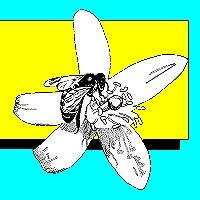APIS Volume 4, Number 11, November 1986

In this issue
- The Competition: Sugar and Health
- More on Wood Preservatives
- New Zealand: AFB, Chalkbrood, Pesticides
THE COMPETITION
I'm always interested in what the competition is doing and receive the Florida Sugar Cane League's publication, Sugar News. The fall issue contained items of interest to those who are promoting and selling sugar. One study, reported from the August issue of Environmental Nutrition, suggests those who use saccharin (a sugar substitute) are more likely to gain weight than those who didn't. Another sugggested that sugar decreased motivation to eat while aspartame (an artificial sweetener) increased feelings of hunger and decreased feelings of fullness, particularly about an hour after eating. The Sugar News' conclusion: "Scientists are on the verge of building evidence that could lead to a public shift away from artificial sweeteners back to sugar."
Another article indicates a Food and Drug Administration task force report says there is no evidence that sugar causes diabetes, hyperactivity in children, nor increases risk of cancer or heart disease. In addition, sugar did not appear to play any unique role in causing obesity. In the words of the report, "There is no conclusive evidence that demonstrates a hazard to the general public when sugars are consumed at the levels that are now current and in the manner now practiced."
Those promoting honey take note that the word "sugars" was used in the report's conclusion. Honey contains several sugars, mostly the simple sugars, glucose and fructose, but also sucrose (the kind being promoted by the Cane Sugar League). Thus, if sugar is deemed not to be a health problem by the Food and Drug Administration, then neither is honey. In addition, honey tastes sweeter (because of its simple sugars), and so less is theoretically needed to satisfy the consumer's sweet tooth. This could translate into more moderate consumption than is possible with sugar. Finally, honey contains those trace nutritional elements not found in pure cane sugar.
MORE ON WOOD PRESERVATIVES
Mr. Jerry Latner of Dadant and Sons, Inc., Umatilla, Florida has kindly sent me a copy of the label of the material he says is approved by those inspecting his operation from both the Food and Drug Administration and Environmental Protection Agency. Its main active ingredient is copper naphthenate (20%). This now appears to be the active ingredient of choice in preserving wooden parts of the beehive. As I noted in the September 1986 APIS, the Environmental Protection Agency is reportedly intending to cancel registrations on wood preservatives containing arsenic, creosote and pentachlorophenol.
NEW ZEALAND NEWS
It is often interesting to look at beekeeping concerns in other areas of the world. Sometimes one assumes that things are different because another language is spoken or currency used. Not so! For example, look at some items from New Zealand Apicultural Advisor Andrew Matheson's publication, Beelines.
The New Zealand beeswax market outlook is poor because:
- Beekeeping is becoming less popular overseas, with fewer people entering the industry or taking it up as a hobby.
- The Roman Catholic church no longer requires candles to be made of pure beeswax; two-thirds or half is ok.
- The cosmetic industry is turning more to synthetics to replace beeswax.
According to Mr. Matheson, the British Bee Journal reports that private analysts checking honey bee samples for insecticide poisoning charge at least 500 British pounds when the insecticide concerned in known and up to 1000 British pounds when it is not.
Another New Zealand Ministry of Agriculture and Fisheries official, Murray Reid, recently reported a beekeeper in his region diagnosing a case of "foulbrood" by the not-to-be-recommended method of olfactory detection (smelling). As the story goes, "He lifted the lid, took a whiff and closed it again to wait for the bee inspector. Well, Murray lifted the lid and smelt a smell too, but it wasn't foulbrood. The odour was coming from a dead mouse on top of the inner-cover? Blush, blush, red face, embarrassment...and another lesson learnt."
You should concentrate on avoiding the conditions which can lead to chalkbrood outbreaks, Mr. Matheson says, rather than trying to keep the spores out of your hives. Specifically:
- Keep colonies strong to avoid stress.
- Requeen regularly with Italian stock, much less prone to the disease than dark races.
- Arrange hives in an anti-drift layout to reduce spore transfer between hive.
- Select breeder queens which show low susceptibility to chalkbrood.
Sincerely,
Malcolm T. Sanford
Bldg 970, Box 110620
University of Florida
Gainesville, FL 32611-0620
Phone (352) 392-1801, Ext. 143 FAX: (352)-392-0190
http://www.ifas.ufl.edu/~mts/apishtm/apis.htm
INTERNET Address: MTS@GNV.IFAS.UFL.EDU
©1986 M.T. Sanford "All Rights Reserved














